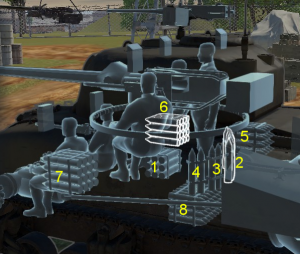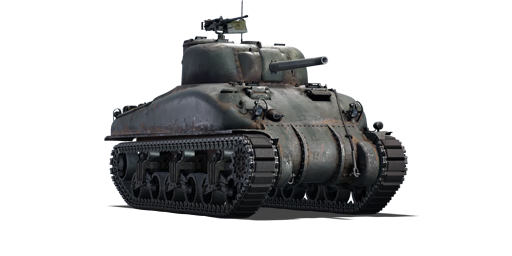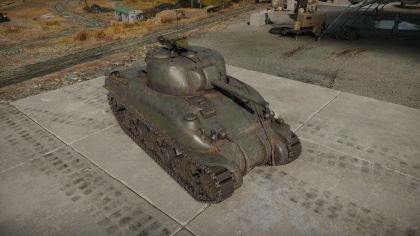M4A1 (France)
Contents
Description
The ▄M4A1 Sherman is a Rank II French medium tank
with a battle rating of 3.3 (AB/RB/SB). It was introduced in Update 1.75 "La Résistance".
The M4A1 Sherman is distinctive from its cast hull construction, causing it to have a curved hull shape. This causes the front hull armour to have a varying slope angle across the glacis, but it also presents several weaknesses. First is in the hull front and side joint with slightly flat angles when angling the tank, the next is the cast construction which diminishes the labeled effectiveness of the front armour. Though at its battle rating, its armour is still effective against certain enemy fire.
The 75 mm M3 gun is mounted in the M34 gun mount with the periscopic , a skinny gun mount compared to the future M34A1 which all future 75 mm M4 Sherman guns are mounted. This lowers the area the gun mantlet covers to contribute to turret front armour, but does present a slightly greater gun depression by -2° than the future M34A1 mounts.
At a battle rating of 3.3, the M4A1 Sherman is a very capable medium tank. The 75 mm M3 cannon is capable of destroying nearly all armoured targets at the battle rating. Combined with the very fast turret traverse rate, fast reload time of 6.5 seconds and a vertical gun stabilizer, this tank is suited to an aggressive play style due to your ability to react quickly and fire relatively accurately without coming to a full stop. The gun depression of -12° also makes this tank excel in hull down positions unlike any other tank. One must take into account this tanks very thin side armour of 38.1 mm thick, anti tank weaponry of any rank will be capable of penetrating this weak side armour so protect your flank.
Beware of this tank's very poor reverse speed as it only has one reverse gear. This affects the tank's ability to play in a defensive role. In addition, this tank is very prone to engine fire, so the FPE is a modification that must be completed ASAP. Also be sure not to let the enemy get sight of your driver and radio operators hull view ports. One single halfway decent shot, even from 20 to 30 mm guns can end you.
General info
Survivability and armour
Armour type:
- Cast homogeneous armour
- Rolled homogeneous armour (Lower side hull)
| Armour | Front (Slope angle) | Sides | Rear | Roof |
|---|---|---|---|---|
| Hull | 50.8 mm (2-64°),19.5 mm (63-84°) Front glacis 50.8 mm (9-56°) Transmission housing |
38.1 mm (1-24°) Top 38.1 mm Bottom |
38.1 mm (0-37°) Top 38.1 mm (13-50°) Bottom |
19.5 mm |
| Turret | 50.8-76.2 mm (18-71°) Turret front 50.8 (3-47°) + 76.2 mm (7-85°) Gun mantlet |
50.8 mm (2-70°) | 50.8 mm (1-67°) | 25.4 mm |
| Armour | Sides | Roof | ||
| Cupola | 50.8 mm | 25.4 mm |
Notes:
- Suspension wheels are 15 mm thick, bogies are 10 mm thick, and tracks are 20 mm thick.
- Front armour slope not even, lower part is weaker than top.
- Belly armour is 12.7 mm thick.
- A small patch on the turret front right side is thinner (50.8 mm) than the rest (76.2 mm).
- Bolt edges on the transmission housing are 101.6 mm thick.
Mobility
| Mobility characteristic | ||
|---|---|---|
| Weight (tons) | Add-on Armour weight (tons) |
Max speed (km/h) |
| 30.6 | N/A | 42 (AB) |
| 38 (RB/SB) | ||
| Engine power (horsepower) | ||
| Mode | Stock | Upgraded |
| Arcade | 620 | 763 |
| Realistic/Simulator | 354 | 400 |
| Power-to-weight ratio (hp/ton) | ||
| Mode | Stock | Upgraded |
| Arcade | 20.26 | 24.93 |
| Realistic/Simulator | 11.57 | 13.07 |
Armaments
Main armament
| 75 mm M3 | |||||
|---|---|---|---|---|---|
| Capacity | Vertical guidance |
Horizontal guidance |
Stabilizer | ||
| 90 | -12°/+18° | ±180° | Vertical | ||
| Turret rotation speed (°/s) | |||||
| Mode | Stock | Upgraded | Prior + Full crew | Prior + Expert qualif. | Prior + Ace qualif. |
| Arcade | 14.28 | 19.80 | 24.0 | 26.60 | 28.20 |
| Realistic | 14.28 | 16.80 | 20.4 | 22.60 | 24.00 |
| Reloading rate (seconds) | |||||
| Stock | Prior + Full crew | Prior + Expert qualif. | Prior + Ace qualif. | ||
| 6.50 | 5.75 | 5.30 | 5.00 | ||
Ammunition
| Penetration statistics | |||||||
|---|---|---|---|---|---|---|---|
| Ammunition | Type of warhead |
Penetration in mm @ 90° | |||||
| 10m | 100m | 500m | 1000m | 1500m | 2000m | ||
| M72 shot | AP | 110 | 109 | 92 | 76 | 62 | 51 |
| M48 shell | HE | 10 | 10 | 10 | 10 | 10 | 10 |
| M61 shot | APCBC | 90 | 88 | 81 | 73 | 65 | 59 |
| Shell details | ||||||||||
|---|---|---|---|---|---|---|---|---|---|---|
| Ammunition | Type of warhead |
Velocity in m/s |
Projectile Mass in kg |
Fuse delay
in m: |
Fuse sensitivity
in mm: |
Explosive Mass in g (TNT equivalent): |
Normalization At 30° from horizontal: |
Ricochet: | ||
| 0% | 50% | 100% | ||||||||
| M72 shot | AP | 619 | 6.3 | N/A | N/A | N/A | -1° | 47° | 60° | 65° |
| M48 shell | HE | 463 | 6.3 | 0.4 | 0.5 | 666 | +0° | 79° | 80° | 81° |
| M61 shot | APCBC | 618 | 6.8 | 1.2 | 20 | 63.7 | +4° | 48° | 63° | 71° |
| Smoke characteristic | ||||||
|---|---|---|---|---|---|---|
| Ammunition | Velocity in m/s |
Projectile Mass in kg |
Screen radius in m |
Screen time in s |
Screen hold time in s: |
Explosive Mass in g (TNT equivalent): |
| M89 | 259 | 3 | 13 | 5 | 20 | 50 |
Ammo racks

| Full ammo |
1st rack empty |
2nd rack empty |
3rd rack empty |
4th rack empty |
5th rack empty |
6th rack empty |
7th rack empty |
8th rack empty |
Visual discrepancy |
|---|---|---|---|---|---|---|---|---|---|
| 90 | 79 (+11) | 67 (+23) | 56 (+34) | 45 (+45) | 34 (+56) | 23 (+67) | 12 (+78) | 1 (+89) | Yes |
Turret empty: 45 (+45)
Machine guns
| 12.7 mm M2HB | ||||||
|---|---|---|---|---|---|---|
| Pintle mount | ||||||
| Capacity (Belt capacity) | Fire rate (shots/minute) |
Vertical guidance |
Horizontal guidance | |||
| 600 (200) | 577 | -10°/+22° | ±60° | |||
| 7.62 mm M1919A4 | ||||||
|---|---|---|---|---|---|---|
| Coaxial mount | ||||||
| Capacity (Belt capacity) | Fire rate (shots/minute) |
Vertical guidance |
Horizontal guidance | |||
| 3,000 (250) | 500 | N/A | N/A | |||
Usage in the battles
As prior stated, the M4A1 Sherman plays best in an aggressive role. Firing on the move is not a difficult task with this tank due to the vertical stabilizer. Take advantage of this tank's immense gun depression of -12°.
The tall profile of the tank is an advantage and disadvantage. In the context of a hull down position, it is an advantage due to you being able to angle the turret down over a hill or crest without having to pull further up the hill. The tall profile however does make you more visible and the tall hull makes it easy to set off an ammo rack.
Pros and cons
Pros:
- Familiar M4 Sherman gamestyle
- Good 75 mm gun, with adequate damage and decent rate of fire
- Frontal glacis is quite hard to penetrate at its rank and tend to make rounds ricochet
- Very fast turret traverse speed
- Thick gun mantlet, and it is a small target
- Very good gun depression -12 degrees
- Very mobile once acceleration kicks in
- Pintle-mounted HMG provides anti-aircraft defense
- Fitted with a vertical stabilizer, allowing more accurate fire on the move compared to other tanks, as well as better usage of shoot-n-scoot tactics
Cons:
- Armour is not as strong against upgunned vehicles like the Panzer IV F2 and the T-34 mod.1942
- The 38.1 mm side armour is vulnerable to even Rank I anti tank fire
- Narrow tracks offer poor ground flotation, thus poor off-road capabilities
- Prone to damage by artillery barrages, tracks can be hit and fuel supply can be ignited
- Ammunition storage is vulnerable to cooking off
- May tip over when travelling across steep inclines
- A shot through hull vision blocks can set off turret's ammo supply and hull sponson ammo and a lucky shot might even knock you out
- Has a high profile especially when compared to other medium tanks
- 50.8 mm weak point on turret's right side.
History
Development
The Battle of France in 1940 proved to America that their current tank arsenal would not be able to withstand a German assault. The only tanks in their inventory at that time was the M2 Light Tanks and the M2 Medium Tank, both are inadequate against the German Panzer IIIs and the Panzer IVs. The US Army, in response, ordered for a tank armed with a 75 mm gun. While a 75 mm gun was available for use, a turret able to mount the gun was not. So while the turret and tank design underwent development, the 75 mm would be mounted on the stopgap design, the M3 Lee tank in a sponson mount. This interim design put the 75 mm on a lower and limited traverse mount that restricted its firing angle, but it did give the Allies a tank with the gun, so it was issued by the thousands until a better design could be made.
During the M3's development, the designs of the 75 mm armed vehicle were being drawn up and submitted by the Ordnance Department. Specifications on the tank design were strict, with restrictions made on the tank's height, width, and weight in order to make it able to be transported over bridges, roads, railroads, and on ships. These specifications would help the army by making the tank be very flexible on strategic, logistical, and tactical grounds. On April 1941, the Armored Force Board chose the simplest of the designs, which was a redesigned M3 hull and chassis with a turret mounting the 75 mm gun designated the T6, completed in September 1941. This tank would then designated the Medium Tank M4 in American service. The tank would become the most used Allied tank during World War II as it was lended out by the thousands in the Lend-Lease program to the Allied countries. The British called the M4 the "Sherman", which coined into the tank's name M4 Sherman that it would be known as in history. The production for the Shermans began on October 1941 and would continue to be produced until the end of the war in 1945 with around 50,000 units produced, making it the second most-produced tank in World War II before the T-34 tank.
Design
Many variants of the Shermans were produced, but they all followed a similar layout. The driver and bow gunner sat in the front driving compartment, the fighting compartment in the middle housed the turret its three crew member, and in the back was the engine compartment. The Sherman used many features present in previous American tank designs, the vertical volute suspension system (VVSS) and radial engine from the M2 Light Tanks, and the sloping armour of the M2 Medium Tanks. This became a contributing factor on the Sherman's reliability on the field, as most of the design flaws were ironed out with the previous tank designs. The tank mounted the 75 mm M3 gun, giving the tank very good AP and HE capabilities. The Sherman's turret traverse speed was very fast, able to traverse a full 360 degrees in only 15 seconds, which is considerably faster than the traverse speed on most German tanks. Another unique feature on the Sherman was the installation of a gyroscopic stabilizer on the gun and sight, making the Sherman one of the first produced tanks to incorporate those features. While the stabilization was only done for the vertical plane, it kept the gun stable enough to be able to shoot on the move effectively, with a study showing a 70 % hit probability on an enemy 300 to 1,200 yards away when moving at a speed of 15 mph. However, this feature was controversial among the crew and experiences with it vary.
The M4A1 Sherman model ran on a gasoline Continental R975C-1 radial engine and was one of the first models of the Sherman developed. The model in-game features the early M38 telecopic sight in the M4 periscope with no zoom, which was later replaced with a M55 telescopic sight in the gun mantlet by recommendation from the British.[1] The tank's hull was fully cast, giving the tank a distinctive rounded slope front and sides. Though the rounded shape gave the frontal armour uneven angling, it provided adequate protection up to 100 mm in thickness in certain areas. Casting the hull took less man hours to perform, but suffered from the limited capability of most American factories and was hard to repair on the field. Thus, welding was prioritized as the primary manufacturing method in the other Sherman variants.[2] Nevertheless, up to 6,281 M4A1s were produced from February 1942 to December 1943, out of the 49,234 Sherman units produced in the war.
French service
After the Fall of France, the Free French force served with the Allies. They soon relied on new modernising equipment from the United States Lend-Lease. From the period of 1943 to the end of the war, the United States supplied a total of 657 M4 Sherman tanks to the Free French, of which 383 were the M4A2 and 274 were the M4A4 Sherman tanks.[3] These tanks, along with M3A3 and M5A1 Stuart light tanks helped formed the Free French armoured divisions (Division Blindée (DB)), which themselves were modeled after the American armoured divisions. The Free French armoured divisions would be committed to the Battle of Normandy in 1944, with the 2nd DB composted entirely of M4A2 while the 1st and 5th DB came with a mixed assortment of M4A2 and M4A4. Replacing lost or worn-down equipment in the Free French armoured divisions led to the issuement of vehicles from the US Army inventory, leading to the presence of the M4, M4A1, and M4A3 Sherman models in the divisions.[4] They have also been seen using M4 Sherman models with different armaments, such as the 76 mm Gun M1 and the 105 mm howitzer.
Media
An excellent addition to the article will be video guides, as well as screenshots from the game and photos.
References
- ↑ Zaloga Steven. Armored Thunderbolt: The U.S. Army Sherman in World War II Stackpole Books, 2008, "Baptism Of Fire"
- ↑ Zaloga Steven. Armored Thunderbolt: The U.S. Army Sherman in World War II Stackpole Books, 2008, "The School of Tank Technology"
- ↑ Zaloga Steven. Armored Thunderbolt: The U.S. Army Sherman in World War II Stackpole Books, 2008, "Appendix C"
- ↑ Vigneras, Marcel. United States Army in World War II: Special Studies. 3 Rearming the French. Washington, DC: Office of the Chief of Military History, Dep. of the Army, 1957. Print. pp.244-246





